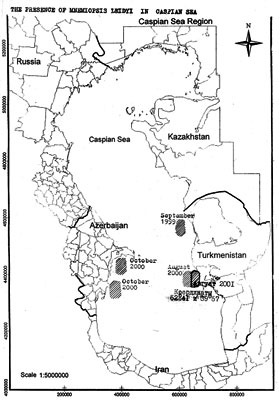Appendix 6 workshop 1
F. M. Shakirova
Introduction of new species, due to unpredictability, is one of the most adverse types of man-made impact and almost always is attended by noticeable changes in structural composition of ecosystems. Introduction of exotic species is particularly dangerous for population of isolated water bodies (such as the Caspian Sea), which often are not able to clamp down on an aggressive invader. Therefore, if settings of the environment are suitable, the population and biomass of such a species can outburst, especially at the initial stage of colonization, due to dwindling population of competitive local species as it was observed with Mnemiopsis leidyi in the Sea of Azov and the Black Sea.
That is why, the discovery of the comb-jelly in the Caspian Sea in 1998-1999 raised great concerns among experts, scientific community and practitioners. Already in April (24-26) 2001, the CEP staged the first International Workshop to discuss the issue of species, particularly Mnemiopsis leidyi, invading the Caspian Sea in Baku (Azerbaijan).
At the meeting, experts from the littoral states delivered the up-to-date information on discovery of the comb-jelly in the sea and canvassed possible implications of its invasion into the Caspian. The meeting stressed the need to conduct constant monitoring of Mnemiopsis n the Caspian Sea using harmonized means and methodology of researches. Ensuing the meeting, regional experts drafted and circulated in July 2001 a report describing tackles, sampling methodology and data processing.

Due to technical reasons, it wasn’t possible to study the stretch from Kara Bogaz Gol to Gasan Kuly in Turkmenistan waters of the Caspian. Therefore sampling was conducted in the vicinity of Turkmenbashi (cape Avaza) in the middle of August 2001 (Fig.1). Sampling was conducted using a small cone net (the diameter of the mouth - 50cm; its area - 0.2m2). Sampling depth was 2-3m, water temperature in surface layer reached 23-250C.
The research has found that the density of ctenophores ranged from 62 to 550 ind./m3, its biomass varied from 32.09 g/m3 to 215.5 g/m3. Its length reached 11-30mm. Smaller comb-jellies prevailed. This concentration of comb-jellies had been observed for a week (14-21 August), then they were not observed, but fishermen reported that comb-jellies appeared again in the beginning of September. In the same time, it is necessary to note that during this period a storm was raising. It might have forced them to retreat seaward. Besides, considerable numbers of ctenophore were found on the waterfront (up to 10 ind/m2).
It is necessary to note that a great number of jellyfish, whose species weren’t identified, were found both onshore and in plankton samples during the research. Their sizes varied from 8 to 11mm, ratio to the ctenophore constituted 1:1.
Document Actions
